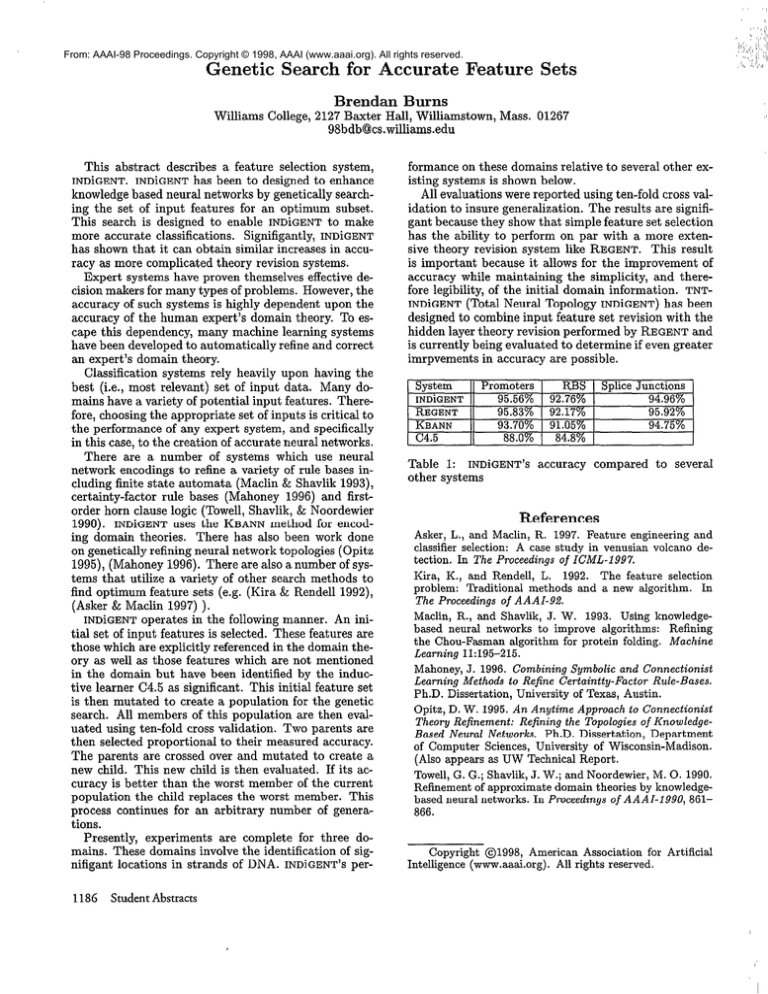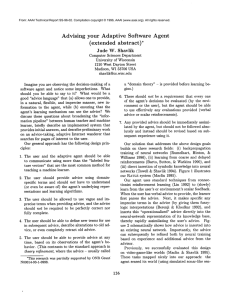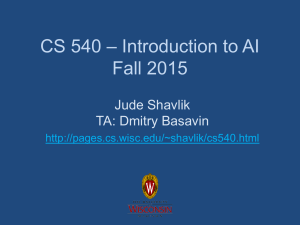
From: AAAI-98 Proceedings. Copyright © 1998, AAAI (www.aaai.org). All rights reserved.
Genetic
Search for Accurate
Brendan
Feature
Sets
Burns
Williams College, 2127 Baxter Hall, Williamstown, Mass. 01267
98bdb@cs.williams.edu
This abstract describes a feature selection system,
INDiGENT. INDiGENT has been to designed to enhance
knowledge based neural networks by genetically searching the set of input features for an optimum subset.
This search is designed to enable INDiGENT to make
more accurate classifications. Signifigantly, INDiGENT
has shown that it can obtain similar increasesin accuracy as more complicated theory revision systems.
Expert systems have proven themselves effective decision makers for many types of problems. However, the
accuracy of such systems is highly dependent upon the
accuracy of the human expert’s domain theory. To escape this dependency, many machine learning systems
have been developedto automatically refine and correct
an expert’s domain theory.
Classification systems rely heavily upon having the
best (i.e., most relevant) set of input data. Many domains haviea var&y of poientia; input features. Therefore, choosing the appropriate set of inputs is critical to
the performance of any expert system, and specifically
in this case,to the creation of accurate neural networks.
There are a number of systems which use neural
network encodings to refine a variety of rule bases including finite state automata (Maclin & Shavlik 1993),
certainty-factor rule bases (Mahoney 1996) and firstorder horn clause logic (Towell, Shavlik, & Noordewier
1990). INDiGENT uses the KBANN method for encoding domain theories. There has also been work done
on genetically refining neural network topologies (Opitz
1995), (Mahoney 1996). There are also a number of systems that utilize a variety of other search methods to
find optimum feature sets (e.g. (Kira & Rendell 1992),
(Asker & Maclin 1997) ).
INDiGENT operates in the following manner. An initial set of input features is selected. These features are
those which are explicitly referencedin the domain theory as well as those features which are not mentioned
in the domain but have been identified by the inductive learner C4.5 as significant. This initial feature set
is then mutated to create a population for the genetic
search. All members of this population are then evaluated using ten-fold cross validation. Two parents are
then selected proportional to their measured accuracy.
The parents are crossed over and mutated to create a
.
ml,.!.~~.cnua
-I-!,., z--.-,..-A-, IIl-c 11;s
1*- ae_ _
new child.
~nis new
is Ll--.tnen evaluatea.
curacy is better than the worst member of the current
population the child replaces the worst member. This
process continues for an arbitrary number of generations.
Presently, experiments are complete for three domains. These domains involve the identification of signifigant locations in strands of DNA. IND~GENT’S per1186
StudentAbstracts
formance on these domains relative to several other existing systems is shown below.
All evaluations were reported using ten-fold cross validation to insure generalization. The results are signifigant becausethey show that simple feature set selection
has the ability to perform on par with a more extensive theory revision system like REGENT. This result
is important because it allows for the improvement of
accuracy while maintaining the simplicity, and therefore legibility, of the initial domain information. TNTINDiGENT (Total Neural Topology INDiGENT) has been
designedto combine input feature set revision with the
hidden layer theory revision performed by REGENT and
is currently being evaluated to determine if even greater
imrpvements in accuracy are possible.
Promoters
System
RBS Splice Junctions
r-h1n;r_n?.1m
QK
ERV a‘
13
7RW
QA
onw
A,.Yl”Ul.
I
““.““,O
“Y..
“10
LJ7..7”
10
REGENT
KBANN
c4.5
95.83%
93.70%
88.0%
92.17%
91.05%
84.8%
95.92%
94.75%
Table 1: INDiGENT’s accuracy compared to several
other systems
References
Asker, L., and Maclin, R. 1997. Feature engineering and
classifier selection: A case study in venusian volcano detection. In The Proceedings of ICML-1997.
Kira, K., and Rendell, L. 1992. The feature selection
problem: Traditional methods and a new algorithm. In
The Proceedings of AAAI-92.
Maclin, R., and Shavlik, J. W. 1993. Using knowledgebased neural networks to improve algorithms: Refining
the Chou-Fasman algorithm for protein folding. Machine
Learning 11:195-215.
Mahoney,J. 1996. Combining Symbolic and Connectionist
Learning Methods to Refine Certaintty-Factor
Rule-Bases.
Ph.D. Dissertation, University of Texas, Austin.
Opitz, D. W. 1995. An Anytime Approach to Connectionist
Theory Refinement: Refining the Topologies of KnowledgeBased Neural Networks. Ph.D. Dissertation, Department
of Computer Sciences, University of Wisconsin-Madison.
(Also appears as UW Technical Report.
Towell, G. G.; Shavlik, J. W.; and Noordewier, M. 0. 1990.
Refinement of approximate domain theories by knowledgebased neural networks. In Proceedzngsof AAAI-1990, 861866.
Copyright 01998, American Association for Artificial
Intelligence (www.aaai.org). All rights reserved.







